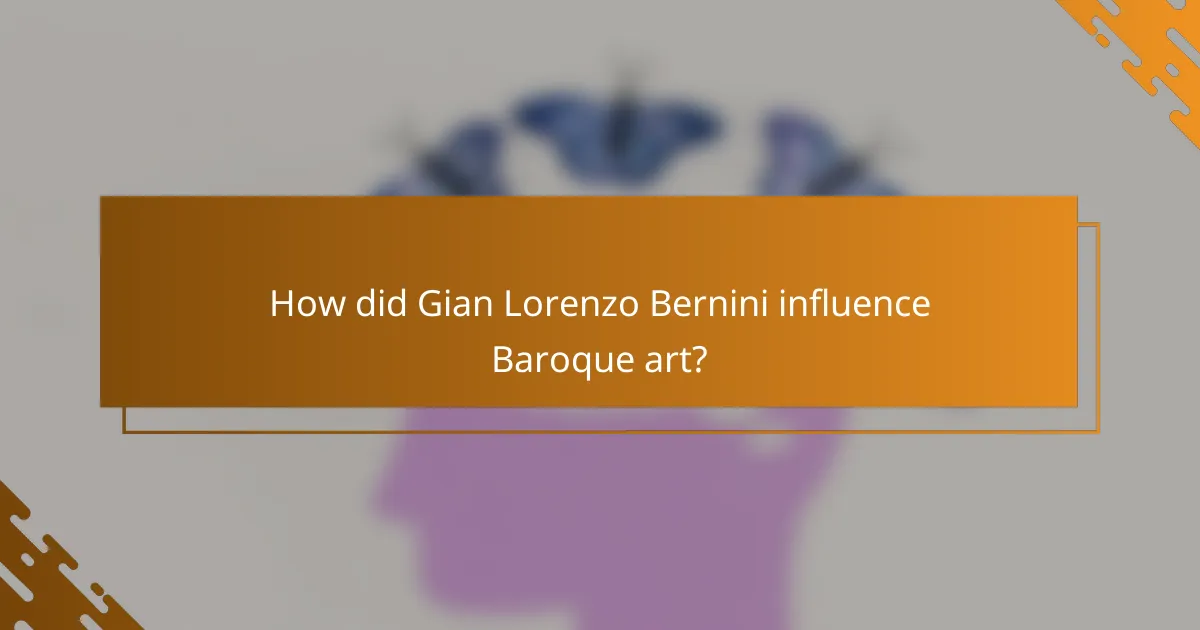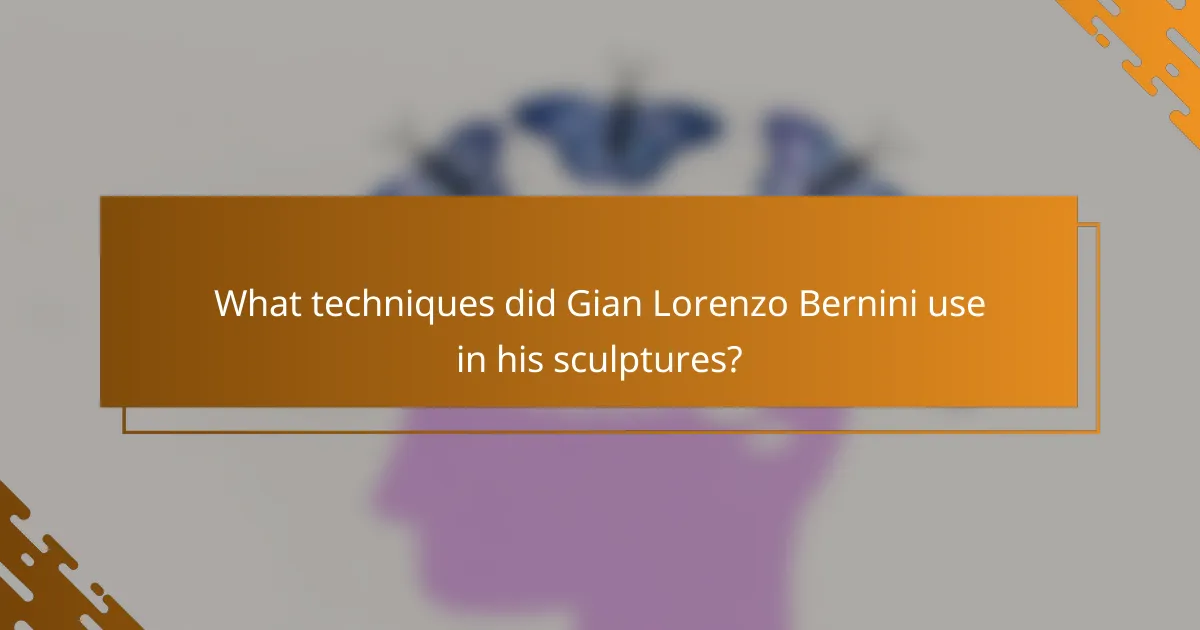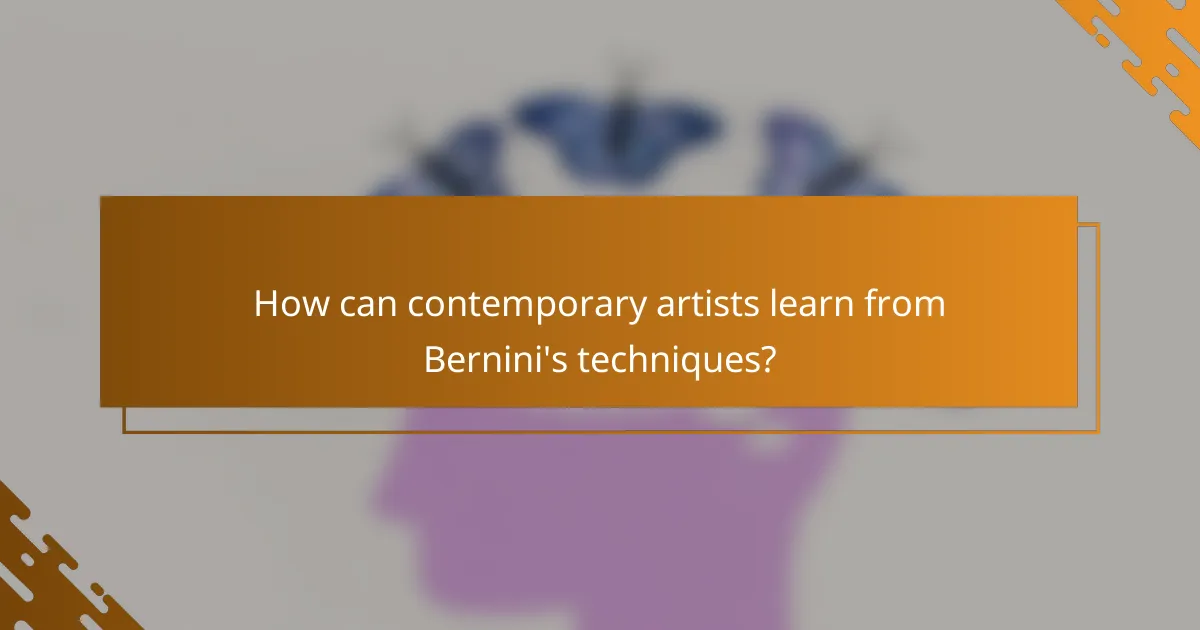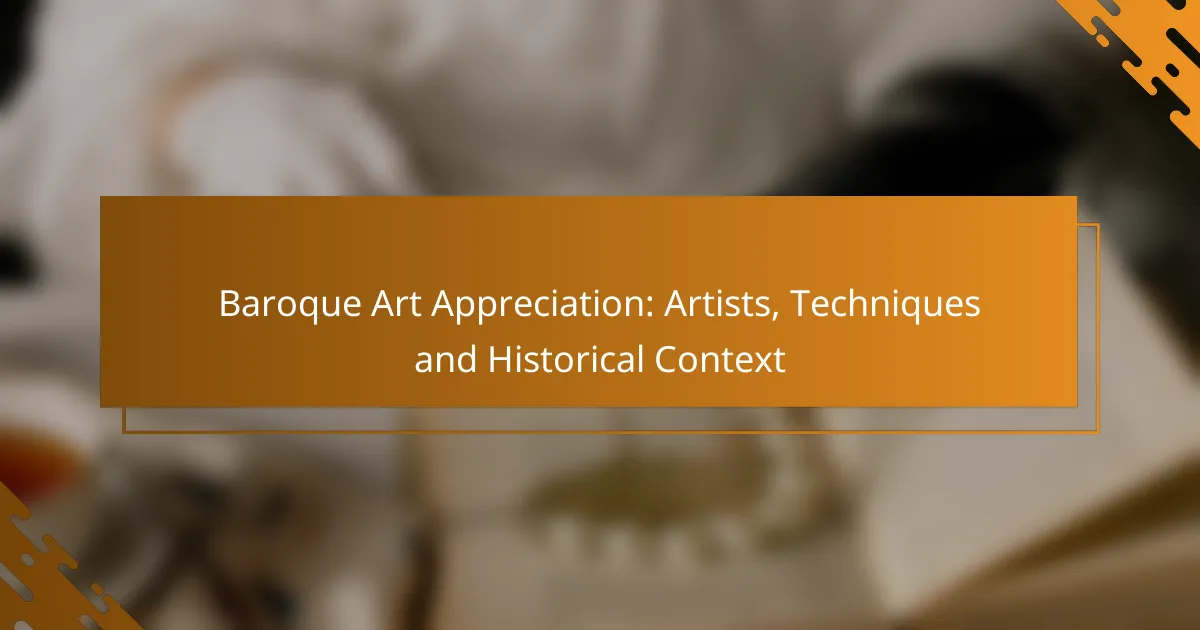Gian Lorenzo Bernini was a pivotal figure in the Baroque art movement, renowned for his innovative techniques and dramatic expressions that transformed sculpture and architecture. His mastery of light and dynamic forms, along with his emotionally charged figures, set new standards in artistic representation, leaving a lasting legacy exemplified by masterpieces such as “The Ecstasy of Saint Teresa” and the Baldachin of St. Peter’s Basilica.

How did Gian Lorenzo Bernini influence Baroque art?
Gian Lorenzo Bernini significantly influenced Baroque art through his innovative techniques and dramatic expressions. His mastery of light, dynamic forms, and the integration of various artistic disciplines set new standards that shaped the movement.
Innovative use of light and shadow
Bernini’s innovative use of light and shadow, known as chiaroscuro, created a sense of depth and drama in his works. By manipulating natural light, he enhanced the emotional impact of his sculptures and paintings, making them appear almost alive. For example, in the “Ecstasy of Saint Teresa,” the interplay of light highlights the figures, drawing the viewer’s eye to the central moment of divine inspiration.
This technique not only emphasized the physicality of his subjects but also evoked spiritual experiences, making the viewer feel a connection to the divine. Artists following in his footsteps adopted similar methods to enhance their own works, solidifying chiaroscuro as a hallmark of Baroque art.
Dynamic compositions in sculpture
Bernini’s dynamic compositions revolutionized sculpture by introducing movement and emotion into static forms. His ability to capture a moment in time, such as in “David,” where the figure is caught mid-action, invites viewers to engage with the narrative. This sense of motion was a departure from the more rigid and static sculptures of the Renaissance.
His sculptures often feature swirling drapery and expressive poses, which convey a sense of energy and life. This dynamic approach encouraged other artists to explore similar techniques, leading to a more animated and expressive style in Baroque sculpture.
Integration of architecture and sculpture
Bernini’s integration of architecture and sculpture created immersive environments that transformed spaces into cohesive artistic experiences. His design of St. Peter’s Basilica’s piazza exemplifies this, where the colonnades embrace visitors, creating a sense of welcome and grandeur. The sculptures within these architectural settings enhance the overall narrative and emotional impact.
This holistic approach encouraged future architects and artists to consider how different mediums could work together to enhance storytelling and viewer engagement. Bernini’s legacy in this area continues to influence contemporary art and architecture, emphasizing the importance of a unified artistic vision.

What techniques did Gian Lorenzo Bernini use in his sculptures?
Gian Lorenzo Bernini employed a variety of innovative techniques in his sculptures that set him apart as a master of Baroque art. His use of chiaroscuro, meticulous marble carving, and the creation of emotionally expressive figures contributed to the lifelike quality and dramatic impact of his work.
Chiaroscuro for dramatic effect
Chiaroscuro, the technique of using strong contrasts between light and dark, was pivotal in Bernini’s sculptures. This method enhanced the three-dimensionality of his figures, making them appear more dynamic and alive. By skillfully manipulating shadows and highlights, he created a sense of movement and depth that drew viewers into the scene.
For example, in his work “The Ecstasy of Saint Teresa,” Bernini’s use of chiaroscuro emphasizes the spiritual experience of the saint, making the moment feel both intimate and powerful. This technique not only adds visual interest but also evokes emotional responses from the audience.
Marble carving for lifelike textures
Bernini’s mastery of marble carving allowed him to achieve remarkably lifelike textures in his sculptures. He employed various tools and techniques to create intricate details, such as the softness of skin, the flow of fabric, and the realism of hair. This attention to detail made his figures appear almost tangible.
His ability to manipulate marble was evident in works like “David,” where the texture of the stone mimics the tension in the figure’s muscles and the fluidity of his pose. Bernini’s skill in carving not only showcased his technical prowess but also enhanced the emotional impact of his sculptures.
Emotionally expressive figures
Bernini’s sculptures are renowned for their emotionally expressive figures, which convey a wide range of human feelings. He captured moments of intense emotion, such as joy, despair, and ecstasy, making his works resonate deeply with viewers. This emotional depth was achieved through careful attention to facial expressions and body language.
In “The Rape of Proserpina,” for instance, the expressions on the faces of Proserpina and Pluto convey a powerful narrative of love and abduction. Bernini’s ability to infuse his sculptures with such emotion not only tells a story but also invites the audience to engage with the work on a personal level.

What are the most famous works of Gian Lorenzo Bernini?
Gian Lorenzo Bernini is renowned for several masterpieces that showcase his exceptional skill in sculpture and architecture. His most famous works include “The Ecstasy of Saint Teresa,” “Fountain of the Four Rivers,” and the Baldachin of St. Peter’s Basilica, each demonstrating his innovative techniques and profound impact on Baroque art.
The Ecstasy of Saint Teresa
“The Ecstasy of Saint Teresa,” created in the 1640s, is one of Bernini’s most celebrated sculptures, located in the Cornaro Chapel of Santa Maria della Vittoria in Rome. This work captures the moment of divine revelation experienced by Saint Teresa of Ávila, showcasing Bernini’s ability to convey intense emotion through marble.
The sculpture features a dramatic interplay of light and shadow, enhanced by the chapel’s architecture. Bernini used a combination of intricate details and flowing drapery to create a sense of movement, making the viewer feel as if they are witnessing a spiritual event.
Fountain of the Four Rivers
The “Fountain of the Four Rivers,” completed in 1651, is a monumental fountain located in Piazza Navona, Rome. This work represents four major rivers from four continents: the Danube, Ganges, Nile, and Río de la Plata, symbolizing the universality of water and life.
Bernini’s design integrates sculptures and architecture, with each river personified by a figure that embodies its characteristics. The fountain’s dynamic composition and intricate details, such as the surrounding obelisk, create a lively atmosphere that attracts visitors and locals alike.
St. Peter’s Basilica Baldachin
The Baldachin of St. Peter’s Basilica, completed in 1633, is a grand canopy that stands over the tomb of Saint Peter. This work is significant not only for its size but also for its intricate design, which combines bronze and architectural elements to create a sense of awe.
Bernini’s use of twisting columns and elaborate ornamentation reflects the Baroque style’s emphasis on drama and movement. The Baldachin serves as a focal point in the basilica, drawing the eye upward and enhancing the spiritual experience of visitors to this iconic site.

How did Bernini’s work reflect the cultural context of 17th century Rome?
Bernini’s work embodied the cultural context of 17th century Rome by merging artistic innovation with the religious fervor of the Counter-Reformation. His sculptures and architecture not only showcased technical mastery but also served to inspire devotion and communicate the power of the Catholic Church during a time of significant religious conflict.
Response to Counter-Reformation ideals
Bernini’s art was deeply influenced by the ideals of the Counter-Reformation, which sought to reaffirm the Catholic Church’s authority and engage the faithful. His works, such as the dramatic sculptures in St. Peter’s Basilica, exemplify the emotional intensity and spiritual engagement that the Church aimed to promote.
By using dynamic poses and intricate details, Bernini created pieces that drew viewers into a narrative of faith and devotion. This approach not only captivated audiences but also reinforced the Church’s message during a period of Protestant challenge.
Patronage from the Papacy
The Papacy played a crucial role in Bernini’s career, providing him with significant commissions that shaped his artistic direction. Notable projects, including the Baldachin in St. Peter’s Basilica and the Piazza San Pietro, were funded by the Church, allowing Bernini to push the boundaries of Baroque art.
This patronage not only ensured financial stability for Bernini but also aligned his work with the Church’s objectives, making his art a tool for religious expression and propaganda. The close relationship between Bernini and the Papacy exemplifies how art and religion were intertwined in 17th century Rome.
Influence of classical antiquity
Bernini’s work was significantly influenced by classical antiquity, which he studied and admired throughout his career. He incorporated elements from ancient Roman sculpture and architecture, blending them with contemporary Baroque styles to create a unique artistic language.
For example, his use of drapery and idealized forms can be traced back to classical models, yet he infused them with a sense of movement and emotion that was characteristic of his time. This synthesis of classical and Baroque elements not only showcased his technical skill but also appealed to the cultural aspirations of 17th century Rome, where a revival of classical ideals was in full swing.

What legacy did Gian Lorenzo Bernini leave in the art world?
Gian Lorenzo Bernini left a profound legacy in the art world, particularly in sculpture and architecture, by merging emotional expression with technical mastery. His innovative techniques and dramatic compositions have influenced countless artists and shaped the trajectory of Baroque art.
Foundation for future sculptors
Bernini established a new standard for sculptors by emphasizing movement and emotion in his works. His ability to capture the human experience through intricate details and dynamic poses set a benchmark that many artists sought to emulate. Techniques such as chiaroscuro, where light and shadow are used to enhance three-dimensionality, became foundational in sculpture education.
Notable sculptors like Antonio Canova and Jean-Baptiste Carpeaux drew inspiration from Bernini’s approach, pushing the boundaries of what could be achieved in stone and marble. His influence is evident in the way contemporary sculptors approach form and narrative in their work.
Impact on public art and architecture
Bernini’s impact on public art and architecture is significant, particularly in Rome, where many of his works define the city’s landscape. His design of St. Peter’s Square, with its grand colonnades, exemplifies how art can enhance public spaces and create a sense of community. This integration of art and architecture has inspired urban planners and architects worldwide.
Moreover, his dramatic fountains, such as the Fountain of the Four Rivers, showcase how public art can convey powerful narratives and engage viewers. These works not only beautify urban environments but also serve as cultural landmarks that attract millions of visitors each year.
Continued relevance in modern art discussions
Bernini’s legacy continues to be relevant in modern art discussions, particularly regarding the emotional and narrative potential of sculpture. Contemporary artists often reference his ability to evoke feelings and tell stories through their own works, demonstrating the timeless nature of his techniques.
Art historians and critics frequently analyze Bernini’s contributions in the context of modern movements, exploring how his methods can inform current artistic practices. His work serves as a case study in the balance between technical skill and expressive content, a topic that remains vital in art education today.

How can contemporary artists learn from Bernini’s techniques?
Contemporary artists can learn from Bernini’s techniques by focusing on emotional expression and experimenting with diverse materials. His mastery in conveying feelings through art and innovative use of materials can inspire modern creators to enhance their own artistic practices.
Emphasizing emotional expression
Bernini’s work is renowned for its ability to evoke deep emotional responses. Artists today can adopt this approach by prioritizing the portrayal of feelings in their pieces, whether through facial expressions, body language, or the overall composition. For instance, capturing a moment of tension or joy can resonate more with viewers.
To achieve this, consider studying human emotions and how they can be visually represented. Techniques such as dynamic poses, dramatic lighting, and contrasting colors can amplify emotional impact. Regularly reflecting on personal experiences can also help artists infuse genuine emotion into their work.
Experimenting with materials
Bernini was known for his innovative use of materials, blending marble, bronze, and other substances to create stunning effects. Contemporary artists can benefit from exploring various materials and techniques, pushing the boundaries of traditional mediums. This experimentation can lead to unique textures and visual narratives.
When experimenting, consider the properties of each material and how they can interact. For example, combining soft textiles with rigid elements can create a striking contrast. Artists should not shy away from trial and error, as this process often leads to unexpected and rewarding results.



